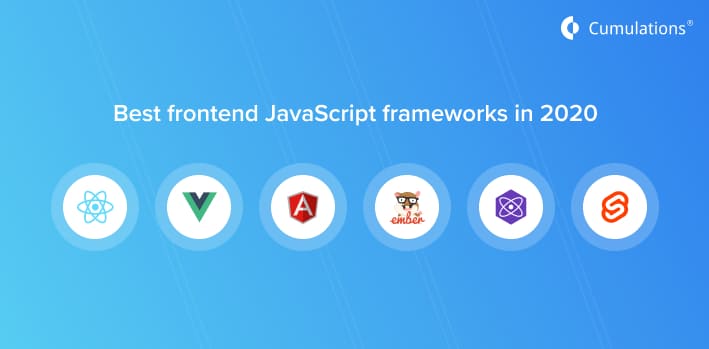
95% of the total of 1.6 billion websites in the world are powered by JavaScript in one or the other way.
Popularly called the language of the web, JavaScript is a standard language that supports functional and event-driven programming styles. Initially, JavaScript was only used for client-side but now it is also used for server-side programming.
Because there are so many JavaScript frameworks available, each one having its own set of advantages and uses, it is becoming increasingly challenging for the developers to choose the best one.
To help you out, we have whittled out a list of the best frontend JavaScript frameworks that are ruling the charts in 2020. We will discuss the many benefits of using these frameworks, especially for single-page applications.
React.js
The leading place on our list of the best frontend JavaScript frameworks definitely belongs to React.js. Although not a full-fledged framework, React is an open-source JavaScript library that was developed by a team of Facebook developers.
React uses a functional, component-based, declarative programming style that enables the development of interactive user interfaces for single-page web apps. It uses Virtual DOM that helps to render only the changed components and not the entire page, thereby improving speed and efficiency. Also, it uses simple JSX syntax that makes the code easier to read and understand.
Must read: Comparing Angularjs vs Reactjs: Most in-demand development framework of 2020
The framework’s component-based approach helps the developers to easily import and reuse UI components without any need for coding them from scratch. Also, its easy integration with other frontend and backend frameworks facilitates easy development.
Although the framework is slightly difficult to learn, however, it is supported by a large community of active developers and extensive learning resources.
Vue.js
Vue.js is another popular open-source, frontend JavaScript framework that helps to develop intuitive, immersive, and creative user interfaces for efficient single-page web applications. Launched by Google developers in 2014, Vue.js adopts most of its features from React and Angular. It strives to deliver a stable, easy to use, and secure framework.
The greatest advantage of using this framework is its simplicity. It has a simple, easy to follow structure that enables the developers to code more while typing less syntax. Also, it uses a single file component system, storing all HTML, CSS, and JavaScript components in a single location.
Moving on, Vue has an in-built MVC that facilitates quick and easy configuration. Also, with this framework, there is no steep learning curve involved.
Another key advantage of using this framework is that it allows easy integration with all existing web apps without any problem for generating new components.
Angular.js
This is indubitably one of the most efficient and powerful open-source frameworks for developing single-page applications. Created by Google engineers, Angular.js secured widespread acclaim and stayed on the top of the list for a long time. After the emergence of React, Angular.js went through a total rewrite and released Angular 2 in 2016, where it addressed all its shortcomings.
The most important change in the new version was the shift from MVW (Model-View-Whatever) architecture to a component-based style that enables reusability. In this, the components can be easily reused throughout the app, thereby promoting efficiency.
One important feature of Angular is the 2-way data binding. This helps to establish a link between Model and View layer in such a way that change in one is automatically reflected in another.
The framework also comes with a rich collection of third-party integrations that help to augment the performance of the web application. It is supported by a huge community of Google developers together with a massive library of resources.
Ember.js
Another one of the popular frontend JavaScript frameworks is Ember.js, an open-source framework ideal for developing scalable enterprise single-page web apps. It is based on the Model-View-View-Model pattern that enables developers to build scalable apps by incorporating best practices into the framework.
One of Ember’s most useful features is its command line interface (CLI) tool. This enables the developers to create new projects with existing setups as well as create controllers, components, and other project files using the option of automatic generation.
The framework shortens the timeline by following a CoC, i.e. Convention over Configuration approach. This eliminates the need for configuration so that the developers can directly begin with coding and building the web app.
Like Angular, Ember also supports 2-way data binding. It comes with an Inspector development extension for Firefox and Google Chrome that helps to modify applications in real-time.
Preact.js
Preact.js is a quick, lightweight, and high-performing framework that is considered as an alternate choice to React. It is very small, barely 3kb in size and packs a punch with all the necessary functionalities included. In other words, it can be considered as a subset of React.
The framework works on the same principle of React, i.e. component-based approach with a Virtual DOM. Thus, in case of projects where the complete functionality of React isn’t needed, Preact is preferred.
The Preact CLI, command line interface helps the developers to create new projects quickly and effortlessly, eliminating the need to deal with the web pack. Besides, the framework is much more efficient in terms of memory usage that reduces the work for the garbage collector.
Another notable feature of Preact.js is its compatibility with React. It uses the same API as React that allows the developers to easily switch to Preact in an ongoing project during the production stage.
Svelte.js
Svelte. Js is another frontend JavaScript framework that is quite popular. Written in Typescript, the open-source, component-based framework was launched in 2016 and has been a leading choice for many ever since.
Svelte has no virtual DOM. Instead, it builds components in simple HTML, CSS, or JavaScript code to surgically update the DOM. This helps it to achieve faster rendering in comparison to other frameworks and build powerful apps with lighting fast speed.
The framework uses the same component-based approach that enables the reusing of the components. Some advanced functions make the task of building reusable components even quicker and simpler. Also, Svelte is easy to learn and highly suited to new developers. The components are built with simple coding and no additional knowledge of JSX or Typescript is needed.
Zero client-side dependencies and the lack of complicated state management libraries are some other notable advantages of using this framework.
Wrapping Up
JavaScript is a popular choice for developing all kinds of web applications. However, choosing the right framework out of the many available is not an easy task. This is primarily because each framework comes with its own set of features and benefits.
It is important to pay attention to all the precise project requirements to decide the type of framework that will work best for your needs. Make sure to take factors like complexity, learning curve, compatibility, and community support into consideration while making the choice.
Related read: Top Nodejs Frameworks for Web & Mobile app development


 +91-984-5825982 | +91-996-4689921
+91-984-5825982 | +91-996-4689921 sales@cumulations.com
sales@cumulations.com Send your requirement
Send your requirement 



